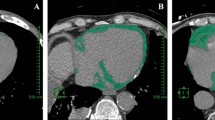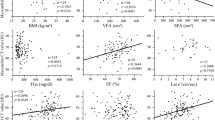Abstract
Aim
The study aimed to examine the association between thoracic periaortic fat tissue volume and the long-term incidence of major adverse cardiovascular events.
Methods
This retrospective cohort study included 433 consecutive patients (372 male and 61 female). Periaortic fat tissue volume was measured via electrocardiogram-gated 64-multidetector computed tomography. The patients were evaluated on an average 3 years of follow-up for major adverse cardiovascular events. The patients were divided into groups according to the presence of major adverse cardiovascular events.
Results
Major adverse cardiovascular events were noted in 44 (10.2 %) patients during follow-up. Periaortic fat tissue volume was significantly higher in the major adverse cardiovascular events (+) group (35.4 ± 26.1 cm3 vs. 24.1 ± 14.9 cm3, P = 0.001). The logistic regression model showed that periaortic fat tissue volume (hazard ratio: 1.03; 95 % CI: 1.01–1.05; P = 0.001), the glomerular filtration rate (hazard ratio: 0.98; 95 % CI: 0.96–0.99; P = 0.03), and male gender (hazard ratio: 4.76; 95 % CI: 1.08–20.90; P = 0.04) were independent predictors of major adverse cardiovascular events.
Conclusion
Thoracic periaortic fat tissue volume may be considered a useful new parameter for predicting major adverse cardiovascular events.



Similar content being viewed by others
References
Spiroglou SG, Kostopoulos CG, Varakis JN, Papadaki HH. Adipokines in periaortic and epicardial adipose tissue: differential expression and relation to atherosclerosis. J Atheroscler Thromb. 2010;17:115–30.
Lee H-Y, Després J-P, Koh KK. Perivascular adipose tissue in the pathogenesis of cardiovascular disease. Atherosclerosis. 2013;230:177–84.
Lehman SJ, Massaro JM, Schlett CL, O’Donnell CJ, Hoffmann U, Fox CS. Peri-aortic fat, cardiovascular disease risk factors, and aortic calcification: the Framingham Heart Study. Atherosclerosis. 2010;210:656–61.
Cheng K-H, Chu C-S, Lee K-T, Lin T-H, Hsieh C-C, Chiu C-C, et al. Adipocytokines and proinflammatory mediators from abdominal and epicardial adipose tissue in patients with coronary artery disease. Int J Obes. 2008;32:268–74.
Fantuzzi G, Mazzone T. Adipose tissue and atherosclerosis: exploring the connection. Arterioscler Thromb Vasc Biol. 2007;27:996–1003.
Trayhurn P. Endocrine and signalling role of adipose tissue: new perspectives on fat. Acta Physiol Scand. 2005;184:285–93.
Iacobellis G, Willens HJ. Echocardiographic epicardial fat: a review of research and clinical applications. J Am Soc Echocardiogr Off Publ Am Soc Echocardiogr. 2009;22:1311–9; quiz 1417–8.
Klopfenstein BJ, Kim MS, Krisky CM, Szumowski J, Rooney WD, Purnell JQ. Comparison of 3 T MRI and CT for the measurement of visceral and subcutaneous adipose tissue in humans. Br J Radiol. 2012;85:e826–30.
Fox CS, Massaro JM, Schlett CL, Lehman SJ, Meigs JB, O’Donnell CJ, et al. Periaortic fat deposition is associated with peripheral arterial disease: the Framingham heart study. Circ Cardiovasc Imaging. 2010;3:515–9.
Thanassoulis G, Massaro JM, Corsini E, Rogers I, Schlett CL, Meigs JB, et al. Periaortic adipose tissue and aortic dimensions in the Framingham Heart Study. J Am Heart Assoc. 2012;1:e000885.
Cockcroft DW, Gault MH. Prediction of creatinine clearance from serum creatinine. Nephron. 1976;16:31–41.
Chityala R, Hoffmann KR, Bednarek DR, Rudin S. Region of Interest (ROI) Computed Tomography. Proc Soc Photo-Opt Instrum Eng. 2004;5368:534–41.
Taylor J. Third universal definition of myocardial infarction. Eur Heart J. 2012;33:2506–7.
Ho KK, Pinsky JL, Kannel WB, Levy D. The epidemiology of heart failure: the Framingham Study. J Am Coll Cardiol. 1993;22:6A–13A.
Talaei M, Sadeghi M, Mohammadifard N, Shokouh P, Oveisgharan S, Sarrafzadegan N. Incident hypertension and its predictors: the Isfahan Cohort Study. J Hypertens. 2013;32(1):38–8.
Gu P, Jiang W, Lu B, Shi Z. Chemerin is associated with inflammatory markers and metabolic syndrome phenotypes in hypertension patients. Clin Exp Hypertens NY 1993. 2013;36(5):326–32.
Diaz-Melean CM, Somers VK, Rodriguez-Escudero JP, Singh P, Sochor O, Llano EM, et al. Mechanisms of adverse cardiometabolic consequences of obesity. Curr Atheroscler Rep [Internet]. 2013[kaynak 27 Eylül 2013];15. Tarihinde adresinden eris¸ ildi: http://link.springer.com/10.1007/s11883-013-0364-2.
Kammoun HL, Kraakman MJ, Febbraio MA. Adipose tissue inflammation in glucose metabolism. Rev Endocr Metab Disord. 2013;15(1):31–44.
Gröber-Grätz D, Widhalm K, de Zwaan M, Reinehr T, Blüher S, Schwab KO, et al. Body mass index or waist circumference: which is the better predictor for hypertension and dyslipidemia in overweight/obese children and adolescents? Association of cardiovascular risk related to body mass index or waist circumference. Horm Res Paediatr. 2013;80(3):170–8.
Jolly US, Soliman A, McKenzie C, Peters T, Stirrat J, Nevis I, et al. Intra-thoracic fat volume is associated with myocardial infarction in patients with metabolic syndrome. J Cardiovasc Magn Reson 2013;15:77.
Karastergiou K, Fried SK. Multiple adipose depots increase cardiovascular risk via local and systemic effects. Curr Atheroscler Rep. [Internet]. 2013[kaynak 25 Eylül 2013];15. Tarihinde adresinden eris¸ ildi: zotero://attachment/91/
Gastaldelli A, Basta G. Ectopic fat and cardiovascular disease: what is the link? Nutr Metab Cardiovasc Dis NMCD. 2010;20:481–90.
Britton KA, Wang N, Palmisano J, Corsini E, Schlett CL, Hoffmann U, et al. Thoracic periaortic and visceral adipose tissue and their cross-sectional associations with measures of vascular function: thoracic periaortic fat and vascular function. Obesity. 2013;21:1496–503.
Baker AR, Silva NF da, Quinn DW, Harte AL, Pagano D, Bonser RS, et al. Human epicardial adipose tissue expresses a pathogenic profile of adipocytokines in patients with cardiovascular disease. Cardiovasc Diabetol. 2006;5:1.
Iacobellis G, Assael F, Ribaudo MC, Zappaterreno A, Alessi G, Di Mario U, et al. Epicardial fat from echocardiography: a new method for visceral adipose tissue prediction. Obes Res. 2003;11:304–10.
Iacobellis G, Ribaudo MC, Assael F, Vecci E, Tiberti C, Zappaterreno A, et al. Echocardiographic epicardial adipose tissue is related to anthropometric and clinical parameters of metabolic syndrome: a new indicator of cardiovascular risk. J Clin Endocrinol Metab. 2003;88:5163–8.
Iacobellis G, Leonetti F, Singh N, M Sharma A. Relationship of epicardial adipose tissue with atrial dimensions and diastolic function in morbidly obese subjects. Int J Cardiol. 2007;115:272–3.
Greif M, Becker A, von Ziegler F, Lebherz C, Lehrke M, Broedl UC, et al. Pericardial adipose tissue determined by dual source CT is a risk factor for coronary atherosclerosis. Arterioscler Thromb Vasc Biol. 2009;29:781–6.
Iacobellis G, Willens HJ, Barbaro G, Sharma AM. Threshold values of high-risk echocardiographic epicardial fat thickness. Obes Silver Spring Md. 2008;16:887–92.
Flüchter S, Haghi D, Dinter D, Heberlein W, Kühl HP, Neff W, et al. Volumetric assessment of epicardial adipose tissue with cardiovascular magnetic resonance imaging. Obes Silver Spring Md. 2007;15:870–8.
Author information
Authors and Affiliations
Corresponding author
Rights and permissions
About this article
Cite this article
Kaya, Z., Ulucan, S., MehmetKayrak et al. The association between thoracic periaortic fat and major adverse cardiovascular events. Wien Klin Wochenschr 127, 191–196 (2015). https://doi.org/10.1007/s00508-015-0722-x
Received:
Accepted:
Published:
Issue Date:
DOI: https://doi.org/10.1007/s00508-015-0722-x




